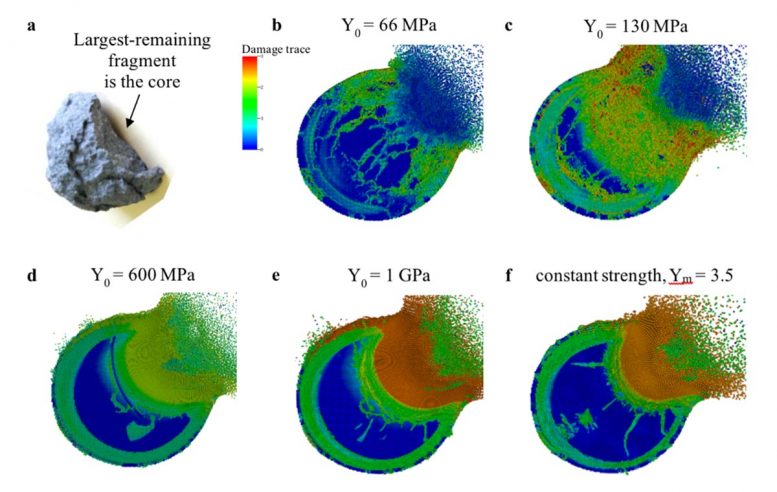
Lawrence Livermore researchers compared the results of asteroid deflection simulations to experimental data and found that the strength model has a substantial effect on momentum transferred. Credit: Lawrence Livermore National Laboratory
Planetary defense researchers at Lawrence Livermore National Laboratory (LLNL) continue to validate their ability to accurately simulate how they might deflect an Earth-bound asteroid in a study that was published in the April issue of the American Geophysical Union journal Earth and Space Science.
The study, led by LLNL physicist Tané Remington, also identified sensitivities in the code parameters that can help researchers working to design a modeling plan for the Double Asteroid Redirection Test (DART) mission in 2021, which will be the first-ever kinetic impact deflection demonstration on a near-Earth asteroid.
Asteroids have the potential to impact Earth and cause damage at the local to global scale. Humankind is capable of deflecting or disrupting a potentially hazardous object. However, due to the limited ability to perform experiments directly on asteroids, understanding how multiple variables might affect a kinetic deflection attempt relies upon large-scale hydrodynamic simulations thoroughly vetted against relevant laboratory‐scale experiments.
“We’re preparing for something that has a very low probability of happening in our lifetimes, but a very high consequence if it were to occur,” Remington said. “Time will be the enemy if we see something headed our way one day. We may have a limited window to deflect it, and we will want to be certain that we know how to avert disaster. That’s what this work is all about.”
This study investigated the accuracy of the codes by comparing simulation results to the data from a 1991 laboratory experiment conducted at Kyoto University, where a hyper-velocity projectile impacted a basalt sphere target.
Remington used an adaptive smoothed-particle hydrodynamics code-named Spheral to produce simulation results that closely resemble the experimental findings. The simulations also helped the researchers identify which models and material parameters are most important to accurately simulate impact scenarios with a brittle, rocky asteroid.
They found that the selection of the strength model and its parameters had a substantial effect on the predicted crater size and the amount of momentum transferred into the target asteroid. In addition to the strength model, the team found that simulation results also are sensitive to strain models and material parameters.
These findings highlight the link between having properly validated codes and having the confidence needed to effectively plan a deflection mission. While no asteroids pose an immediate threat to Earth, LLNL researchers are collaborating with the National Nuclear Security Administration and NASA in the development of a modeling plan for the DART mission. These findings will help the team hone its modeling plan for DART.
The DART spacecraft will launch in late July 2021. The target is a binary (two asteroids orbiting each other) near-Earth asteroid named Didymos that is being intensely observed using telescopes on Earth to precisely measure its properties before impact. The DART spacecraft will deliberately crash into the smaller moonlet in the binary asteroid — dubbed Didymoon — in September 2022 at a speed of approximately 6.6 kilometers/second. The collision will change the speed of the moonlet in its orbit around the main body by a fraction of 1 percent, but this will change the orbital period of the moonlet by several minutes — enough to be observed and measured using telescopes on Earth.
“This study suggests that the DART mission will impart a smaller momentum transfer than previously calculated,” said Mike Owen, LLNL physicist, coauthor on the paper, and developer of the Spheral code. “If there were an Earth-bound asteroid, underestimating momentum transfer could mean the difference between a successful deflection mission and an impact. It’s critical we get the right answer. Having real-world data to compare to is like having the answer in the back of the book.”
Reference: “Numerical Simulations of Laboratory‐Scale, Hypervelocity‐Impact Experiments for Asteroid‐Deflection Code Validation” by T. P. Remington, J. M. Owen, A. M. Nakamura, P. L. Miller and M. Bruck Syal, 20 February 2020, Earth and Space Science.
DOI: 10.1029/2018EA000474

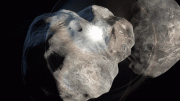
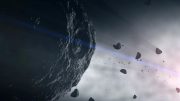
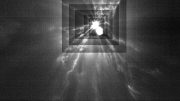
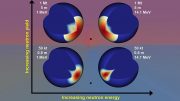
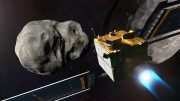
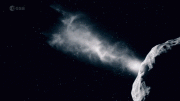
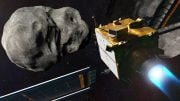
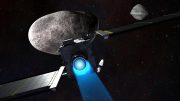
No DART will be able to stop the star Wormwood.
With accounting of the results of computer simulations I can agree with numerous doubts about the expected effectiveness of the impact approach to asteroid deflection. Moreover, the “porosity of very loose aggregates” of all NEAs (through and through!) is not at all the “monolith porosity” used in the model. The detailed photos and probe impacting of asteroids Bennu and Ryugu revealed and confirmed their natural rubble-pile properties. Such an internal structure will completely prevent shock wave propagation and proper impulse transfer. The low-velocity ejection of asteroid material will most likely also not lead to a sufficient push for the same reasons – it will require escaping of many thousands of tons to achieve it. By the way, it seems strange the lack of preliminary conducting much cheaper laboratory/field experimental tests with compliance of the scale of masses and velocities. For example, a bullet shot at a very large “bag” with stones of various sizes and interferometric measurements of its possible displacement. Therefore it is unlikely that the kinetic impact will work being neither effective nor scalable even to asteroids capable of country-wide destruction.
As of now, based on system analysis, it is clear that asteroid ablation using highly concentrated sunlight is the only method that meets all of the following criteria: scalability up to global-threat sizes and any type of hazardous bodies as well as low cost and environmental friendliness. This method converts the asteroid to a “natural rocket”, providing more than enough thrust without fuel and energy concerns.
An improved concept for such solar-based deflection using an innovative solar collector was proposed and substantiated back in 2013 – see https://link.springer.com/article/10.1007%2Fs11038-012-9410-2
and also a short demo-video
https://www.youtube.com/watch?v=9u7V-MVeXtM
Star wormwood?